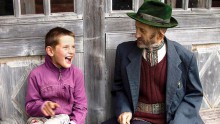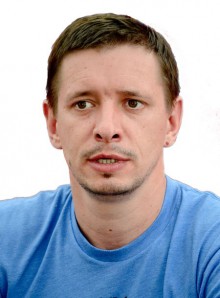Film director Ostap Kostiuk has been studying Hutsul culture for over 10 years. The Living Fire is a result of this study and his full-length debut. It took him four years to shoot this film.
The Living Fire’s characters are Ivan Besashchuk, 82; Ivanko Mykhailiuk, 10, and his godfather; Vasyl Toniuk, 39. Vasyl, a stern, burly, and self-disciplined man, manages the polonyna (alpine pastureland) Radul, the only one of the district’s 78 polonynas where sheep farming is practiced. Besashchuk has been taking flocks of sheep to the mountains for 40 years, but now he, a widower absorbed in reminiscences, is living out his days in a lonely house. Ivanko is only learning the essentials of sheep grazing. The living fire is a bonfire (“vatra”) made by wood rubbing and kept burning throughout the four-month season of pasture. The rite of kindling this fire was performed in the Hutsul area until the mid-20th century. This fire in the film is a symbol of today’s decline of sheep farming.
At first glance, Kostiuk follows the traditional stylistics of “poetic cinema” – landscape panoramic sequences, folklore in everyday life, etc. But the further the story unfurls, the more it is clear that the author cares about two things: the visual environment (cameraman – Oleksandr Pozdniakov) and personalities of the characters. Doing a clear and smooth job on the editing table, the director does not intend to build any special dramaturgic structure – he just uses the things he has, such as views of the Carpathians, the movement of flocks, everyday life details, the change of light in the frame, changes in the mood of the little Ivanko, the chat of the old Ivan. The child’s ingenuity and the old man’s sincerity film very well, which Kostiuk aptly knows. One more advantage is the soundtrack that easily combines such different things as atmospheric electronics of the Kyiv composer Alla Zahaikevych, folk tunes solo and in chorus, accordion-accompanied pop songs, the ringing of sheep’s and church bells, the crowing of roosters, the sounds of trembitas, and wind.
This is not yet artistic anthropology but, on the other hand, no longer farfetched pseudo-ethnics. Kostiuk managed to draw his own, not hackneyed, poetics from the material shown a hundred times.
As a result, the film won a special prize at Hot Docs, North America’s largest documentary film festival held annually in Toronto, Canada; the American Cinematographer Magazine Award for Cinematography at Salem Film Fest (USA), a diploma “for expressing a hope to preserve national culture in the conditions of globalization” at the Listapad festival in Belarus. It was also recognized as the best documentary film at the 18th Olympia International Film Festival for Children and Young People (Greece).
Before the Kyiv premiere, Kostiuk answered The Day’s questions.
What was your previous experience? For, as far as I know, you have no specialized cinematic education.
“I studied history at Lviv University and, concurrently, attended a theatrical studio. After finishing the latter, I worked at the Lviv Les Kurbas Theater. The theater devoted much of its attention to folk music and songs. They began to try to put archaic rituals onto stage. A question arose at the time about how to express ancient music in its natural quality, how to help performers, who are often unused to the stage, not to lose their organic spirit, and how to show this vanishing world in all its fullness and color. Working at the theater, I could not only improve my acting mastery, but also learn dramaturgy and stage direction. This helped me very much later to adjust the script of a film. Immediately after leaving the theater, I worked on several musical projects – from folk to ethno-fusion with electronic music. I play now at Lviv’s Hycz Orkestr.”
What actually brought you into cinema?
“I liked watching films. When it became not enough, Oleksandr Pozdniakov and I went in for filmmaking. A lot of work, mistakes, and search awaited us. But, to learn to do something, you must begin to do this one day… We were no longer satisfied to see a simple statement of historical facts or an unemotional account of events in the text. We thought it was more important to tell stories by way of images in order to cause a stir in the feelings and empathy.”
What did Hutsul culture attract you with? What is it unique in?
“It is a figurative and very much romanticized stereotype that Hutsuls are colorful free-thinking highlanders. Every culture is unique, and all cultures are interesting in their diversity. But it is also important to know in what we are universal. What can make our problems common to all of humankind? What can make our experience be of interest to others? In my opinion, what sounds from inside you is a thing of your own. I would call it self-recognition. We often seek the uniqueness of ‘our own’ and treat ‘our own’ as something self-evident. But the actual functioning of culture is more important. What is happening to this Hutsul myth at present? How is this culture doing today? In reality, it is losing its own way of life and the source that begets this uniqueness. What are we to do with this ‘own’ – hand it over to the museum or push it onto the stage? We tried to spotlight this in film, for it is perhaps the only way to keep a phenomenon alive.”
What struck you most of all when you worked on the film? And what was the most difficult?
“It is most difficult to find an impartial attitude and distance to yourself, to this ‘own’ and ‘inner.’ And what struck me is different – it really hurts when you have already finished work but have to put up with the fact that your hero may die. But, in reality, it is the humanistic value of cinema to show that a mortal transient individual may come down in history as a strong living character.”
Shooting a film is a long and exhausting process for everybody. What did you do to relieve the excessive tension?
“I would take a musical pause. Shepherds liked Hutsul tunes, so I entertained them playing the Hutsul bagpipe. I play a few ancient tunes, we all listen and sing together, and then get back to work. Music exposes and unites people. I think now: it’s funny that a pipe can be a director’s instrument. But it worked! And the entire previous experience also works for you.”
You have studied the culture of Hutsuls for over 10 years. To what extent has this experience changed you?
“What has changed me is close contacts with people who sincerely share their life stories. To know something is one thing, and to go on doing something is quite a different thing. There are not many shepherds left in the Hutsul area, and I look on those who still do this work as true artists who, in spite of all circumstances, pursue their favorite occupation, even though it is commercially unprofitable. Why? Because it is their way of life – the mountains are their element, as is the sea for the sailor. They feel natural and strong in that environment.”
Would you say a few words about your new film?
“I have just begun to do preliminary work and prepare documentation. We are watching a family from a milieu that is close to me. It’s the story of a father and a daughter, where the child’s line is intertwined with that of the father who has come back from war and is seeking himself anew. This is a story about a toy that was played with and thrown away. It’s about the destiny of the defenders who are coming home after going through horror. The war, which has ended on the battlefield, continues in the families. This must be understood.”
Do you have a clear vision of your future as a filmmaker? Are you prepared to drop other occupations in favor of cinema?
“I’ve already had to drop. It’s a difficult profession. I find it easier to work when I think about a concrete assignment, study the chosen topic, and do not think much about the future. I could get lost if I were to reflect whether or not I am a filmmaker. I believe I must work hard and then everything will be the way it should be – or, in the worst case, it will not (I’m joking). But even if it is not, well…, ‘we just walked, we don’t have a grain of untruth with us.’ We did not stretch the truth but were doing what we had chosen. One must pay for the freedom to create, and, clearly, we’ll have to give up many things. Yet I think the most important thing is to answer the now arising questions. Every film is an individual problem and an individual approach, and one has always to start from scratch. And it is thrilling to discover the unknown even in the humdrum of everyday life.”
The Day’s FACT FILE
Ostap KOSTIUK is a film director, actor, and musician. He was born in 1979 in Kolomyia, Ivano-Frankivsk oblast, graduated from the History School of Lviv National Ivan Franko University and the actors’ studio of the Les Kurbas Theater. He debuted, in collaboration with Oleksandr Pozdniakov, in 2011 as director of the short film Manu and Cabbages which won a RADI (Agence du Court Metrage) distinction in France. The Living Fire is his full-length film debut.










